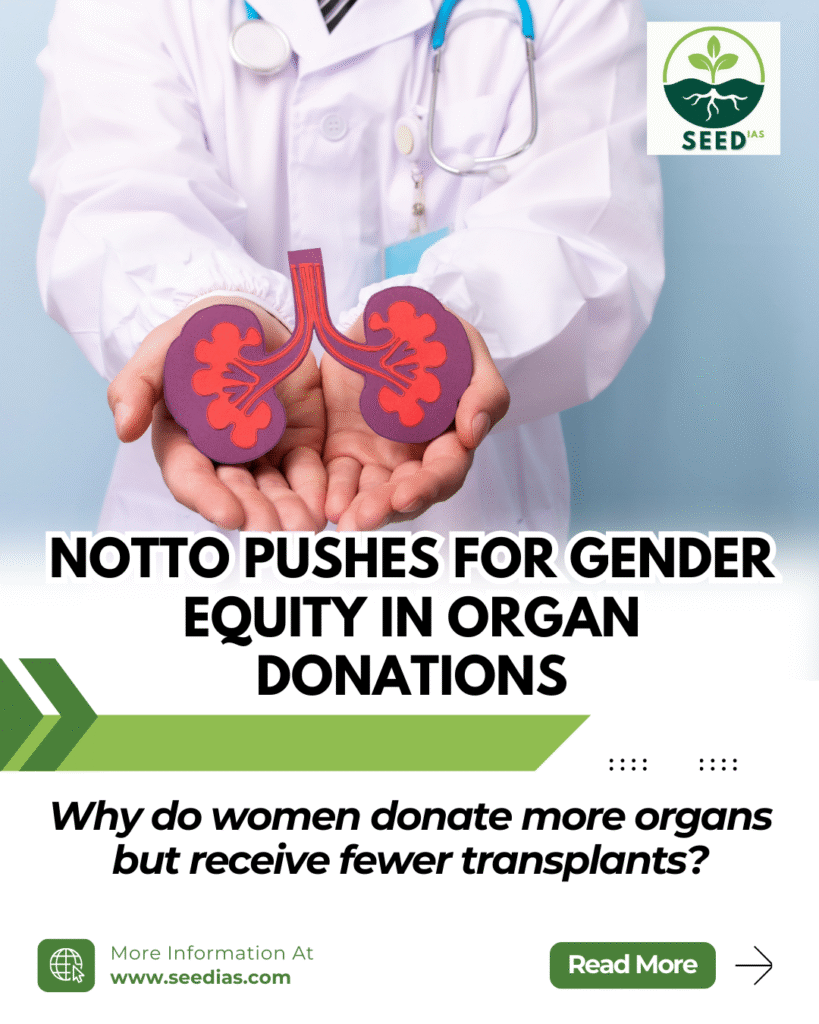Why in NEWS
A recent report by the Union Ministry of Health and Family Welfare has revealed alarming deficiencies in India’s organ transplantation system. With only 13,476 kidney transplants in 2024—far below the estimated need of 1 lakh—the findings signal a crisis in accessibility, infrastructure, and regulation, demanding immediate systemic overhaul.
Key Concepts & Definitions
| Term | Explanation |
|---|---|
| Organ Transplantation | Surgical procedure replacing a failing organ with a healthy donor organ |
| Living Donor | A healthy person donating a kidney or liver segment |
| Deceased Donor | Brain-dead or cardiac-death donor |
| Brain-Stem Death (BSD) | Legal death condition where vital organs can be donated |
| NOTTO | Apex body under Ministry of Health coordinating organ donation and transplant |
| Ayushman Bharat | Flagship health scheme providing financial protection |
| THOT Act, 1994 | Law governing organ/tissue transplantation in India |
Present Status and Key Findings
| Parameter | Details |
|---|---|
| India’s Global Position | 3rd in organ transplant numbers after USA and China |
| Organ Demand vs. Supply | 1.8 lakh kidney failure cases yearly vs. ~13,000 transplants (2024) |
| Donation Rate | Below 1 per million population (vs. need of 65 pmp) |
| Donor Growth (2014–2022) | From 6,916 to 16,041 (modest increase) |
| Regional Leaders | Telangana, TN, Karnataka (deceased); TN, Delhi-NCR, Kerala (living donors) |
| Regulatory Steps | Removed 65-year age cap and domicile clause for receiving organs (2023) |
Organ Transplantation Framework
| Component | Description |
|---|---|
| Transplantation Act, 1994 | Legal basis for donation, transplant, and penal actions |
| National Organ Transplant Program (NOTP) | Centrally funded program promoting state-level transplant systems |
| NOTTO | Apex coordination and registry body under NOTP |
| ROTTOs & SOTTOs | Regional (5) and State-level (14) bodies to decentralize the transplant network |
| NOTTO-ID | Unique ID for transplant tracking, mandatory for all surgeries |
Gaps in India’s Organ Transplantation Programme
| Gap Type | Explanation |
|---|---|
| Infrastructure Deficiencies | Lack of Transplant ICUs, dedicated OTs, and HLA labs in many government hospitals |
| Shortage of Experts | Few transplant surgeons, nephrologists, and anesthetists in public hospitals |
| Procedural Delays | Delays in BSD committee approvals and medico-legal formalities |
| Financial Burden | High cost of post-op care; immunosuppressants covered only for 1 year |
| Exclusion from Health Schemes | Liver, heart, and lung transplants excluded from Ayushman Bharat |
| Donor Organ Wastage | Inferior quality and ischemic injuries cause high discard rates |
| Chronic Rejection | No major advancement in long-term survival therapy over past 2 decades |
| Access & Awareness Gaps | Poor public infrastructure, absence of green corridors, and low donation awareness |
| Ethical & Legal Issues | Organ trafficking, black markets, and consent problems persist |
Strategies for Improvement
| Strategy Area | Recommendations |
|---|---|
| Infrastructure | Upgrade government hospitals with TICUs and HLA labs; standardize transport |
| Fast-tracking Processes | Digitalize BSD approvals and simplify medico-legal trauma cases |
| Financial & Policy Reforms | Extend Ayushman Bharat to cover heart/liver/lung transplants; subsidize drugs |
| Skilled Workforce | Retain transplant teams; launch fellowships and incentives |
| Research and Innovation | Fund xenotransplantation, AI-based matching, and organ preservation tech |
| Public Awareness | Campaigns via media, schools, religious groups, and donor recognition drives |
| Ethical Safeguards | Transparency in consent, tracking, and allocation mechanisms |
In a nutshell
Memory Code: “ORGAN: Overhaul Rules, Gear-up Access, Nurture lives”
- Overhaul infrastructure
- Retain experts and incentivize teams
- Gear-up government schemes to reduce cost
- Awareness through media, education, and religion
- Nurture ethical, tech-led donation practices
Prelims Practice Questions
- Which of the following statements is true about India’s deceased organ donation rate?
A. It is more than 65 per million population
B. It is around 1 per million population
C. It is increasing by 10% annually
D. It is above China’s donation rate - NOTTO is primarily responsible for which of the following?
A. Manufacturing artificial organs
B. Conducting transplant surgeries
C. Coordinating and regulating organ donation across India
D. Providing insurance for transplant patients - Which of the following changes was introduced in the 2023 organ transplant guidelines?
A. Increase in upper age limit to 70 years for organ donors
B. Removal of domicile and upper age limit for receiving deceased donor organs
C. Mandatory organ donation in brain-stem death cases
D. Direct cash transfer to living donors
Mains Practice Questions
- Highlight the key infrastructural and policy gaps in India’s organ transplantation programme. Suggest measures to improve access and affordability. (10 marks)
- “A robust organ donation system not only saves lives but also enhances India’s global medical credibility.” Discuss in the context of recent reforms and persistent challenges. (15 marks)
Prelims Answers Table
| Q No. | Answer | Explanation |
|---|---|---|
| 1 | B | India’s deceased donation rate remains under 1 per million |
| 2 | C | NOTTO coordinates organ procurement, distribution, and maintains registry |
| 3 | B | 2023 guidelines removed domicile requirement and 65-year age cap |
















